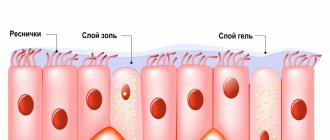Types of cough
Cough can be physiological or pathological.
1. Physiological is short-term, there are no other symptoms of disease, there is no discomfort or inconvenience.
This type of cough is absolutely natural and does not require treatment! A physiological cough is needed to clear the airways of mucus and foreign particles that accumulate in the child’s airways. The mechanism of physiological cough is as follows: air under high pressure leaves the respiratory tract, taking with it mucus and foreign bodies (dust, crumbs, etc.). Healthy children cough up to 20 times a day, and infants cough even more often.
Signs of physiological cough:
- The child is active and the cough does not interfere with his daily activities (continues to play active games if there is a cough)
- Physiological cough is short-term - lasts a few seconds and does not recur in the near future
- The cough may recur throughout the day, but its timbre and duration remain unchanged.
- Lack of lethargy, fever, preservation of appetite (no well-known symptoms characteristic of the onset of the disease)
2. If the cough is pathological , attacks cause a lot of inconvenience. Additional unpleasant symptoms occur, including shortness of breath. Various factors can provoke the development of cough in children. Before starting treatment, it is necessary to establish the cause of this symptom, this will help to prescribe therapy most competently.
Here are some of the most common causes of pathological cough:
- an infectious process or an allergic reaction in which the receptor apparatus of the mucous membrane of the respiratory system is irritated;
- development of broncho-obstructive syndrome;
- penetration of a foreign object into the respiratory tract;
- enlarged regional lymph nodes that compress the airways;
- diseases of the digestive system, cardiac apparatus or vascular system, neurological pathologies.
How to treat a cough in a 2 year old child
Cough is a nonspecific symptom, as it accompanies many respiratory, cardiovascular, and endocrine diseases. Its diagnostic value increases when certain features are identified - timbre, frequency, productivity, duration, etc.
Until the cause of the disease is determined, a small child must be protected from sudden changes in temperature and strong odors. They further irritate the cough receptors, causing the cough to become spasmodic.
Depending on the presence of sputum, cough in young children can be:
- Wet (productive) - accompanied by the secretion of mucus, which can have a different shade and consistency. Glassy mucus is a sign of bronchial asthma, purulent mucus is a sign of bacterial inflammation, with bloody streaks is a sign of diseases of the cardiovascular system and tuberculosis in a child.
- Dry (non-productive) – not accompanied by mucus secretion. Manifests itself at the initial stage of tracheitis, pneumonia, bronchitis.
The pediatrician will tell you what to do if your child has a coughing attack after the examination.
To clarify the reasons, the following are prescribed:
- clinical blood test;
- sputum analysis;
- bronchoscopy;
- laryngoscopy;
- skin allergy tests;
- rhinoscopy.
Therapy is aimed at eliminating the cause of symptoms - infection, allergic reaction. Many cough medications are contraindicated for preschool children. Due to weakness of the respiratory muscles, it is difficult for them to cough up mucus. Therefore, medications are selected with caution. Otherwise, stagnation of sputum and complications - chronic bronchitis, pneumonia - are possible.
General recommendations
Comprehensive cough treatment leads to a shorter recovery period. To speed up the healing of the mucous membranes of the ENT organs, you need to follow the regimen prescribed by your pediatrician. The child should be protected from factors that provoke new coughing attacks.
Pediatricians advise ventilating the room every 2-3 hours and doing wet cleaning daily using antiseptics.
General recommendations for caring for a sick child:
- Peace. It is better for the baby to have a separate room where he can relax and sleep.
- Bed rest. The baby should be kept in bed for 3-5 days. By limiting physical activity, the risk of rapid progression of infection and complications is reduced.
- Temperature conditions. The temperature in the child's room is maintained at 20-22°C.
- Air humidity. If the initial cough is dry, the humidity in the room should be increased to 65-70%. If there is no humidifier, place cups of water on heating radiators or hang wet towels in the room.
- Drink plenty of fluids. When sweating and fever occurs, the child is given a warm drink. Metabolic products and toxins are eliminated along with sweat, so symptoms of intoxication do not appear.
To spare the ENT organs, follow a diet. Products that irritate the mucous membranes are excluded from the child’s menu:
- citrus;
- seeds;
- peanut;
- spices;
- sorrel, etc.
During the treatment period, the basis of the diet is mashed potatoes, liquid porridge, oatmeal with dried fruits.
Warm milk, weak tea, and sweet natural juices are useful to drink.
Pharmacy tablets and syrups
Before treating a child’s cough at 2 years old, you need to find out its productivity. If sputum cannot be separated, antitussives are used. They are divided into 2 groups - central and peripheral action. The former inhibit the activity of the cough center in the brain, and the latter reduce the sensitivity of the receptors in the throat.
Treatment of dry cough with antitussives
| Drug groups | Titles | Active ingredients | Features of reception by children 2-3 years old |
| central action | Kodipront | codeine | ½ tsp. syrup 1-2 times a day |
| Sinekod | butamirate | 15 drops 1 time per day | |
| Sedotussin | pentoxyverine | up to 3 mg per 1 kg of weight 1 time per day | |
| peripheral action | Levopront | Levodropropizine | 1 mg per 1 kg of weight up to 3 times a day (diluted in 100 ml of water) |
| Libexin | prenoxdiazine | ¼ tablet up to 3 times a day (for body weight over 25 kg) | |
| Helicidin | helicidin | 2 ml/kg/day in 3 divided doses |
Antitussive syrups and tablets are used only for non-productive cough, which is caused by pleurisy, whooping cough, ARVI (in the first 2 days).
To speed up the recovery of a child aged 2-2.5 years, the doctor will prescribe medications that transform a non-productive cough into a wet one.
They are divided into 2 groups:
- secretolytic (mucolytics) - reduce the viscosity of mucus, which facilitates its discharge;
- secretomotor (expectorant) - stimulate coughing and removal of mucus from the respiratory tract.
Mucolytics and expectorants for children over 2 years old
| Drug names | Analogs | Reception features |
| Acetylcysteine | Asibrox Atsestad Acetsex ACC 100 Sanorin-broncho | 200-400 mg, divided into 2 doses |
| Carbocisteine | Mucosol Bronchobos Bronkatar Fluditek | 1 measuring spoon (5 ml) up to 2 times a day |
| Bromhexine | Phlegamine Bisolvon Bromhexine Grindeks Solvin | 2 mg up to 3 times a day |
| Lazolvan | Ambrobene Mukoangin Ambroxol Bronchoval Ambrolitin | 2.5 ml up to 3 times a day |
| Gedelix | Broncholex Dr. Theiss Cough Syrup Herbalor ivy | ½ measuring spoon up to 3 times a day |
The duration of treatment depends on the child’s condition and ranges from 5 to 10 days.
If the cough does not go away, contact your pediatrician or otolaryngologist.
Warming rubs
Children under 2 years of age should not be given mucolytic drugs, which increase the volume of sputum in the lungs. To reduce its viscosity and facilitate removal, warming rubs are used. They increase the tone of the respiratory muscles and increase blood flow to the lungs, thereby increasing the lumen of the bronchi. Therefore, phlegm is easier to cough up.
Rubbing is used without exacerbation of allergic dermatoses and in the absence of damage to the child’s skin - ulcers, burns, scratches.
For colds, the following are used for rubbing:
- Eucalyptus balm from Dr. Theiss;
- Doctor Mom with camphor;
- Adjikold-plus;
- Suprima Plus;
- Doctor Mom Cold Slave;
- Vicks Active with menthol.
For severe coughs, home remedies that have a warming and expectorant effect are no less effective:
- Goose fat. The fat is melted in the microwave. Apply to the chest and back before bed. If desired, add juniper, fir or eucalyptus oil. Perform the procedure 2-3 days in a row.
- Cream with mustard. 2 tbsp. l. baby cream is mixed with 1/3 tsp. dry mustard. Apply the product to the back and feet before bed for 3 days.
- Honey ointment. To 100 ml of melted honey add 30 ml of aloe juice, 2 g of propolis, 1 tsp. melted beeswax. Heat over the fire until a homogeneous mass is obtained. The cooled ointment is applied to the chest and back for 2-3 hours in the morning and evening.
If redness or rashes remain on the skin after using homemade rubs, this indicates an allergy. Therefore, it is better to abandon folk remedies for cough in favor of pharmaceutical ointments and balms.
Herbal infusions
Folk remedies for cough are not inferior in effectiveness to pharmaceutical syrups with mucolytic action. To strengthen the immune system, thin sputum and heal mucous membranes, use infusions with:
- chamomile;
- wild rosemary;
- sage;
- linden blossom;
- St. John's wort;
- coltsfoot;
- thyme;
- lemon balm;
- peppermint;
- licorice;
- plantain;
- licorice;
- elecampane.
Before giving your child infusions and decoctions, consult your pediatrician. Some herbs are highly allergenic, and therefore sometimes provoke skin itching, abdominal discomfort, and rashes.
How to cure a child's cough:
- Recipe No. 1. Coltsfoot is mixed with marshmallow and oregano in equal quantities. 1 tbsp. l. pour ½ liter of boiling water over the mixture. Leave in a thermos for 2 hours. Drink 30-50 ml 1 hour after meals.
- Recipe No. 2. 1 tbsp. l. sage mixed with ½ tsp. pine buds and licorice. Steam in 1.5 liters of water. After 2 hours, filter. Take 50 ml up to 3 times a day.
For colds, you should give your child only warm drinks.
The duration of the course is from 4 to 7 days.
Compresses
If a 2-year-old child has bronchitis, warm compresses help. The procedure must be performed in the morning and evening.
How to make compresses for coughs at home:
- Recipe No. 1. Boiled potatoes are thickly mashed and formed into a flat cake. Place it on your back until it cools down.
- Recipe No. 2. Add 1 tsp to 50 ml of melted honey. dry mustard and 30 ml radish juice. Apply the product to the back, cover with polyethylene and a towel. After 20-25 minutes, the compress is removed.
After the compress, the child is covered with a warm blanket and asked to lie down for at least half an hour.
Other folk remedies
An otolaryngologist will explain how to relieve a cough in a small child. In order not to stuff it with drugs, you can use local treatment. Warm-moist inhalations are recommended for children 2-3 years old. Therefore, the liquid temperature should not exceed 40-42°C.
Inhalation products:
- Herbal collection. Mix plantain, peppermint and chamomile in equal proportions. 10 g of raw material is boiled for 5 minutes in 1 liter of water. Add 3-5 drops of eucalyptus oil.
- Potato. Several peeled tubers are boiled in a saucepan for 20 minutes. Without draining the water, mash the potatoes with a fork and cool to 40°C.
Inhalations are done for 3-5 minutes up to 3 times a day.
To avoid nausea and vomiting, the procedure is performed 1 hour after eating. To reduce inflammation in the throat, gargle. Use herbs with anti-inflammatory and immunostimulating effects. Gargling solutions:
- Calendula and sage. Mix 1 tbsp. l. herbs, pour 250 ml of boiling water. Leave in a thermos for 2 hours. Rinsing is done 3-4 times a day.
- Calamus and oak bark. The raw materials are mixed in equal proportions. 3 tbsp. l. the collection is boiled in 1 liter of water for 10 minutes. Gargle with filtered broth 3 times a day.
For a dry cough, warm alkaline drinking - mineral water (Smirnovskaya, Essentuki No. 4) and milk - will help soften the throat and eliminate the feeling of a coma.
Massage
A chest massage will help get rid of a cough in a small child with bronchitis and congestive pneumonia. By improving blood circulation, the function of external respiration and the drainage ability of the lungs are enhanced. It is recommended to use massage oil during the procedure. Using stroking movements from bottom to top, the intercostal muscles and chest are worked out. After 20-25 minutes, apply a warming rub.
Why does a cough appear?
1. The most common cause of coughing attacks is an inflammatory process of viral or infectious etiology .
A cough can develop in the upper or lower respiratory system or affect the entire respiratory system. Depending on the location, the type of this symptom is determined. It can be dry or wet. Also, the type of cough is determined by the type of pathogen.
The cough will be dry if it develops:
- parainfluenza;
- respiratory syncytial infection;
- whooping cough;
- cytomegalovirus infection.
With these diseases, the production of bronchial secretions is disrupted. A dry cough appears. It is usually intense, annoying, painful. If an adenoviral infection develops, this is accompanied by swelling of the mucous membrane, its surface becomes loose. This causes an increase in the amount of sputum and mucous contents. In this case, the cough is wet, productive, and a large amount of sputum is released.
With the development of rhinosinusitis, sinusitis, and adenoiditis, a lingering cough appears. The cause is postnasal drip, which is when mucus from the nasopharynx drains down the back wall of the larynx. wet at night . In the morning, after the child wakes up, the cough is also wet, but phlegm also comes out. During an examination of the patient, the doctor notes the flow of mucus down the back of the throat into the respiratory tract. This irritates the cough receptors.
If bronchitis or pneumonia develops, with properly prescribed treatment, the dry cough becomes productive, wet, and sputum begins to separate from the lower respiratory tract. In such cases, it is very important to carefully prescribe cough medications or to thin sputum. Only a doctor can determine whether in a particular case an antitussive drug is needed to suppress the reflex or a mucolytic to reduce the viscosity of mucus and make it clear more quickly.
Inhalation therapy should also only be prescribed by a doctor. Not in every case, inhalations can reduce symptoms and alleviate the course of the disease. In some cases, after inhalation therapy, the child’s condition worsens.
Causes of acute cough
Acute cough is one of the most common reasons why children consult a doctor. According to experts, every year in Russia from one to two million people suffer from acute respiratory viral infections and approximately twenty percent of them seek help from a doctor due to an acute cough.
One of the main features of an acute cough is its persistence; the child coughs almost all the time. In most cases, an acute cough serves a protective function and helps clear the airways of infection and phlegm.
It is ARVI that is the main cause of acute cough, especially non-productive cough. With ARVI, cough in children most often develops due to inflammatory processes in the upper respiratory tract, where cough receptors are located. Also, with ARVI, a cough may appear due to the fact that secretions from the upper respiratory tract irritate the cough receptors, which in medical practice is called “postnasal drip.”
Moreover, if timely treatment is not applied, an acute cough during ARVI can become post-infectious, which lasts more than eight weeks. Often, a viral infection is also accompanied by a bacterial one (this may be indicated by the green or yellow color of the sputum), which leads to the development of complications: pneumonia, bronchitis.
Acute laryngotracheitis is another common cause of cough in children under 5 years of age. This is an inflammation of the mucous membranes of the larynx and trachea, which can be caused by various reasons: infection, trauma to the larynx, allergies. In this case, the child has a dry, rough, “barking” cough, the voice may become hoarse, and breathing may be difficult. Laryngotracheitis can lead to serious complications; to prevent this from happening, you must seek medical help.
Broncho-obstructive syndrome
Another cause of coughing attacks is broncho-obstructive syndrome. This is accompanied by prolongation of exhalation, the appearance of whistling noisy breathing, and attacks of severe suffocation. The cough is most often unproductive and annoying.
Broncho-obstructive syndrome develops due to the development of viral respiratory infections. The development is also caused by contact with an allergen, this is one of the signs of bronchial asthma.
To diagnose broncho-obstructive syndrome, doctors prescribe chest x-rays and spirometry. To exclude the allergic origin of the disease, a consultation with an allergist is scheduled. An effective treatment method is inhalation therapy.
Foreign object in the respiratory tract
The development of coughing attacks can be triggered by the penetration of a foreign object into the respiratory tract. In this case, the child becomes very anxious. Shortness of breath occurs, the cough is painful, dry, reflex.
In this case, it is very important not to panic. It is necessary to calm the baby so that he can breathe more calmly. Next, it is imperative to call emergency help as quickly as possible, since the effectiveness of treatment depends on how promptly parents contact specialists.
How to determine the cause of a child's cough
If the cough is not associated with diseases of the respiratory system, other symptoms additionally appear. For example, stomach pain, heart pain, headache. In this case, you will need to consult a neurologist, gastroenterologist, or cardiologist. Only a doctor can determine why a child has a cough. You should not self-medicate and use medications or use dubious methods of alternative medicine.
To determine the cause of the cough, you need to consult a doctor in time. A timely visit to a specialist will determine how correctly the diagnosis is made, as well as how correct and timely the therapy is. The doctor will be able to prescribe rehabilitation courses in a timely manner - physiotherapy, massage, halotherapy. It is also necessary to undergo preventive procedures in order to reduce the risk of re-development of the pathological process.
When is it necessary to see a doctor?
Cough against the background of acute respiratory infections is benign, subject to competent and timely treatment.
If therapy is not carried out or there is no positive dynamics, make an appointment with a pediatrician.
You should immediately consult a doctor if you have the following symptoms:
- prolonged fever;
- loud cough;
- tearfulness;
- sweating at night;
- weight loss;
- pale skin;
- shallow breathing;
- hoarseness of voice;
- feverish condition;
- lethargy;
- holding your breath;
- expectoration of sputum streaked with blood.
If your child is coughing a lot, sweating, eating or sleeping poorly, do not delay a visit to a pediatric ENT specialist or pediatrician. Symptoms indicate damage to the lower respiratory tract, which is fraught with complications.

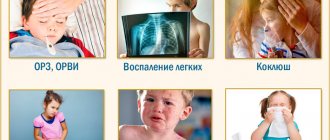
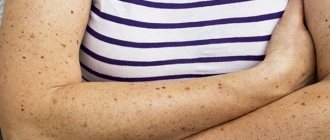
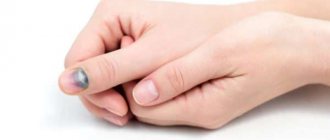


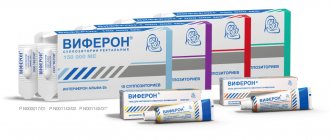

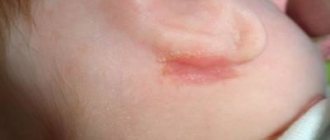
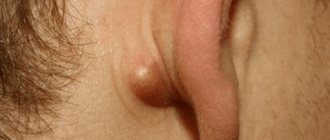
![shutterstock_1111315238 [converted].jpg](https://dou10ugansk.ru/wp-content/uploads/shutterstock_1111315238-preobrazovannyj-jpg-330x140.jpg)
